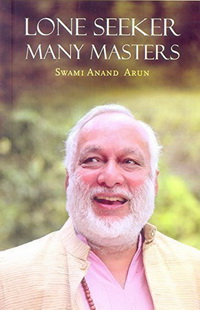Two reviews of Anand Arun’s recently published book – by Paripurn and by Prem Geet.
 I’ve read Arun’s book twice now, and will certainly read it again. Or rather, I’m presently browsing through it again, and keep stumbling upon the many treasures abundantly present in the book; and reading these, I feel even more happy than the last time…
I’ve read Arun’s book twice now, and will certainly read it again. Or rather, I’m presently browsing through it again, and keep stumbling upon the many treasures abundantly present in the book; and reading these, I feel even more happy than the last time…
Happy, because it gives me great joy to read so many colourful stories about so many enlightened beings; many of them were unknown to me until I read the book. Happy, because Arun tells these stories so radiantly filled with love. Happy, because I feel lucky to have a chance to get an impression of an old culture, drenched with spirituality, a culture that due to my western upbringing had previously been largely unknown to me.
Some names of these enlightened masters however, were familiar to me, since Osho spoke about them many times with great love, explaining their songs – Kabir, Gautama the Buddha. About some others masters Arun says Osho spoke on them, probably in Hindi, since I didn’t recognize the titles of those books. Like on Nanak’s “Japuji Saheb, the holy book of the Sikhs. In his book Ek Omkar Satnam Osho has revived the essence of Sikhism for modern mind.”
Often the Indian names of the masters resemble each other so much (for my western mind), that I get confused anyway. But this is not a point at all. The book is not meant to memorise names – it’s just a feast to read these exuberant stories all of which basically contain the same message and often resemble Osho’s message. Arun writes in his introduction, ‘Before you embark’: “I am usually surprised that enlightened masters often share the same opinion, the same expression, and at times the exact same words. They speak from the same source.”
The first chapter The Silent Mystic describes Arun’s meeting with a yogi who unexpectedly came to Arun’s parents’ house when Arun was still very young and wrestling with his meditation. This yogi had no name and did not speak; he carried a slate with him on which he wrote answers to Arun’s questions such as, “I’m not your Guru. You will find your Guru in the right time. I heard your cry for help and came to Janakpur to help you. Your thirst is what will take you to your Guru one day.” Arun says he had darshan with Osho three years later. On the third day of the yogi’s visit Arun asked one of his last questions: “What shall I call you?”- to which the yogi answered, “You can call me Mastaram (the divinely intoxicated one).” Later on in the book Arun speaks about a saint called Mastaram Baba.
Reading Arun’s book I often feel familiar with his descriptions, as if I had a previous life in India or Nepal. When I arrived at Osho Tapoban, the beautiful commune near Kathmandu, three years ago, I very strongly got the feeling that yes! – now I have found my real family…
I chose a few chapters from Arun’s book that are very dear to me. First: the chapter about Osho. This chapter is extremely touching – what else could it be… Arun’s description of when he saw Osho for the first time is pure poetry.
Just lifting the tip of the veil: “Acharya Rajneesh walked in. He had a very graceful way with his body. His hands had the beauty and the precision of a dancer. Now he folded his hands in Namaste, now he held the seam of his lungi gently and now he stroked his beard. (…) He looked like a numinous being who had just descended from the land of the rishis. Acharya Rajneesh sat down on the podium and closed his eyes. (…) “My beloved ones…” Acharya began his discourse. My heart started to beat in violent spasms and tears rolled down my cheeks unchecked. A long forgotten chamber of my heart had opened, some long-lost beloved was remembered.”
The second chapter is about Indira Devi. Arun often had satsang with this beautiful female mystic. He spoke about her to Osho, as he also spoke to Osho about other enlightened people he had met. Osho never discouraged Arun about meeting these mystics. For instance about Gokhle Baba Osho said to Arun: “He is simple and honest but a man of great spiritual insight. Meet him often and serve him as much as you can. This will help your own journey as well. And through you it will help him. The two of you have meditated together in a previous life…”
Then there is the chapter about Yashodhara. Arun ends with these lines: “I’m often moved to tears when I read the accounts of Yashodhara’s selfless and unceasing devotion towards the Buddha. Pushing her into obscurity, Buddhism has not only undermined a woman who was a rare flowering but also deprived many seekers from understanding an integral part of the Buddha’s life”.
Also the chapter about Shivapuri Baba is dear to me. Manjula and I often meditated in the little Shivapuri Baba Temple at Tapoban. His beautiful portrait is prominently present in our meditation room.
Finally, from the ‘chosen few’ chapters – Ma Anand Madhu. She is the very first sannyasin who was initiated into sannyas by Osho. Osho deliberately chose to initiate a woman as his first sannyasin. There’s an extremely beautiful photograph of Madhu and Arun in the book, seated next to each other, hand in hand, with closed eyes… Madhu is still alive. Arun ends this chapter with these words: “Mysticism lives in Ma Madhu in the most human form. She portrays divinity as a personal bearing. So humanlike and yet so divine! The strong energy field around her influences everyone who comes to her presence. (…) Ma Madhu is a presence that can only be understood when one understands the absence that surrounds her.”
And yes, there are quite a few chapters dedicated to more well-known male mystics such as Vivekananda, Raman Maharshi, Ramakrishna Paramhansa, Paramhansa Yogananda (Arun: “It is a great loss to humanity that Swami Yogananda’s body should be secluded in a mortuary while millions of seekers could have easily benefitted if only his body had been interred in a proper Samadhi.”), Krishnamurti, the Dalai Lama, Nagarjuna, Sariputra and Mahamodgalyan. Each of those stories have their own beauty.
At the end of the chapter about Krishna I am citing here from a long quote by Osho: “When the glow and the glamour of all other godmen and messiahs has dimmed, when the suppressive religions of the world have been consigned to the wastebasket of history, Krishna’s flame will be heading towards its peak, moving towards the pinnacle of its brilliance.”
I am ending this review with another quote from Arun’s introduction: “As time passes, my love and dedication towards my master is increasing, and as my trust is growing for Osho, my understanding of all other masters is also deepening equally. (…) My humble request is, be honest, be open and keep your quest burning. You cannot select your master because you are ignorant. Accept your ignorance. Let your heart wander freely in the open sky of spirituality. If your search is genuine your real master will select you in the right time.”

Antar Paripurn
Available at amazon.com – amazon.in











‘Lone Seeker Many Masters’ by Swami Anand Arun is for Osho lovers a ‘must read’. It describes thirty-one little-known enlightened masters throughout history. A masterful storyteller and scholar, Arun reveals a deep understanding of transforming human consciousness as it relates to every spiritual seeker’s inward turn and upward climb. Unifying readers across disparate traditions and cultures, these vivid stories of ‘Many Masters’ illuminate the seeker’s archetypal and universally shared motivations, pitfalls, and rewards on the spiritual journey, yesterday and today.
Arun’s book is a delightful departure from religious writing about the world’s primary spiritual masters, Jesus, Buddha, Mohammed, Mahavira, and Lao Tzu. His colorful and sensitive portrayal of awakened individuals further expands the rainbow of enlightened masters who graced this earth as unique people without doctrine or affiliation. As a gift from existence, the awakened ones described by Arun attained self-realization as individuals, naturally, just as a rose opens, without fanfare. This book showcases these most-rare human beings while giving hope to readers in every condition that they are not in a garden of suffering but that they too can awaken.
Swami Anand Arun’s inspired book is destined for the best seller list in the areas of human consciousness and spirituality. Like his spiritual peers and great authors Carolyn Myss, Huston Smith, Thich Nhat Hahn, and Joseph Campbell, Arun reveals the deepest truth about love, soul, reality, and freedom.
Prem Geet is a regular contributor to Osho News
Previously posted on Smashwords




Comments are closed.